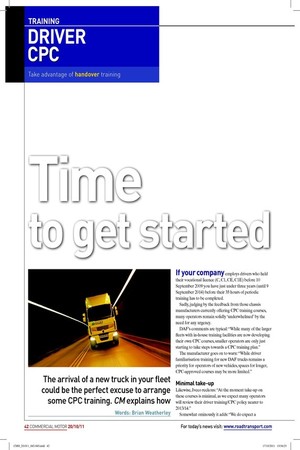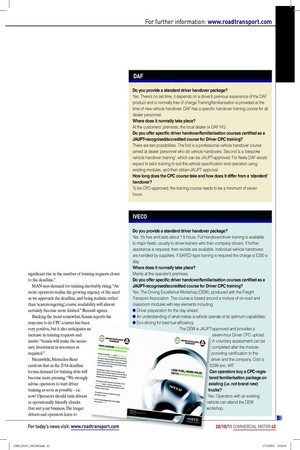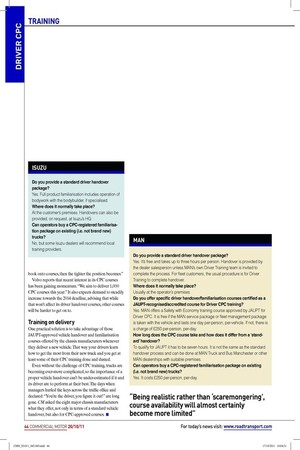to get starte
Page 32

Page 33

Page 34

If you've noticed an error in this article please click here to report it so we can fix it.
The arrival of a new truck in your fleet could be the perfect excuse to arrange some CPC training. CM explains how
Words: Brian Weatherley
If your company employs drivers who held their vocational licence (C, C1, CE, C1E) before 10 September 2009 you have just under three years (until 9 September 2014) before their 35 hours of periodic training has to be completed.
Sadly, judging by the feedback from those chassis manufacturers currently offering CPC training courses, many operators remain solidly ‘underwhelmed’ by the need for any urgency.
DAF’s comments are typical: “While many of the larger leets with in-house training facilities are now developing their own CPC courses, smaller operators are only just starting to take steps towards a CPC training plan.” The manufacturer goes on to warn: “While driver familiarisation training for new DAF trucks remains a priority for operators of new vehicles, spaces for longer, CPC-approved courses may be more limited.”
Minimal take-up
Likewise, Iveco reckons: “At the moment take-up on these courses is minimal, as we expect many operators will review their driver training/CPC policy nearer to 2013/14.” Somewhat ominously it adds: “We do expect a signiicant rise in the number of training requests closer to the deadline.” MAN sees demand for training inevitably rising. “As more operators realise the growing urgency of the need as we approach the deadline, and being realistic rather than ‘scaremongering’, course availability will almost certainly become more limited.” Renault agrees.
Bucking the trend somewhat, Scania reports the response to its CPC courses has been very positive, but it also anticipates an increase in training requests and insists: “Scania will make the neces sary investment in resources as required.” Meanwhile, Mercedes-Benz cautions that as the 2014 deadline looms, demand for training slots will become more pressing. “We strongly advise operators to start driver training as soon as possible – i.e.
now! Operators should train drivers in operationally friendly chunks that suit your business. The longer drivers and operators leave to book onto courses, then the tighter the position becomes.” Volvo reports that recent interest in its CPC courses has been gaining momentum. “We aim to deliver 1,000 CPC courses this year.” It also expects demand to steadily increase towards the 2014 deadline, advising that while that won’t affect its driver handover courses, other courses will be harder to get on to.
Training on delivery
One practical solution is to take advantage of those JAUPT-approved vehicle handover and familiarisation courses offered by the chassis manufacturers whenever they deliver a new vehicle. That way your drivers learn how to get the most from their new truck and you get at least some of their CPC training done and dusted.
Even without the challenge of CPC training, trucks are becoming ever-more complicated, so the importance of a proper vehicle handover can’t be under-estimated if it and its driver are to perform at their best. The days when managers hurled the keys across the trafic ofice and declared: “You’re the driver, you igure it out!” are long gone. CM asked the eight major chassis manufacturers what they offer, not only in terms of a standard vehicle handover, but also for CPC-approved courses. ■










































